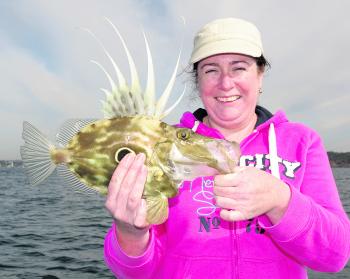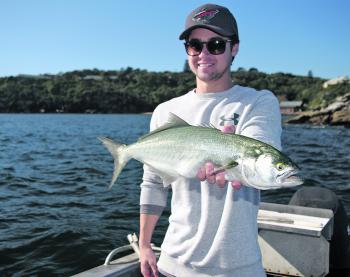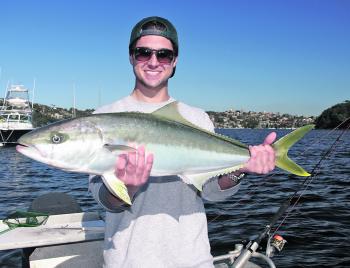The warm water retreat has been slow this year, and as a result the winter species are only just starting to trickle in. The upside is that kings are still hanging round the harbour and due to some huge seas, fish like snapper and drummer have been going nuts in close.
Dory have started to turn up in the lower reaches and so have salmon and some very big tailor. Blackfish have been on fire, although the weed bait has been rare after a prolonged pounding from up to 10m seas. Trevally are also starting to show.
Trevally are a great fish to catch and very underrated as an eating fish. When they are hooked properly, which is rare, they are as good as any of the best pelagics and a very similar taste to kingfish. Raw they are sensational, and in Japan are among the highest rating as sashimi.
They generally like deep clean water and can be found well upstream during dry conditions. I’ve seen them caught as far up as the Roseville Bridge in Middle Harbour and Cockatoo Island in the main harbour. The upstream fish are big, however they are usually on their own and not found in the large schools common on the lower reaches. They are mostly taken as a welcome by-catch when bream fishing
Further down on the lower harbour, they are wide spread and are found around the channels, headlands, boat moorings and deep holes. At night and the low light periods of dusk and dawn they will move into shallower regions. Sow and Pigs is a classic dark spot as is the shallows around Balmoral and Washaway Beach.
Unlike most fish, trevally are not so fussy about fresh bait and, in fact, I’ve found they have a preference for baits like salted mackerel, day old pilchard fillets and slightly iffy prawns, over live nippers or blood worms. Maybe it’s a symptom of the competitiveness created by living in large schools.
Use heaps of berley and fish your baits as lightly weighted as possible. A light, 3kg eggbeater outfit works the best, as it allows you to fish with the bail open and allow a natural drift down the trail. Don’t rush hooked fish, as you will be using small hooks (no. 4 baitholder style hooks are great) and they have soft mouths, so there’s a good likelihood of a tear if you go nuts.
Occasionally, you will see trevally feeding on top, at which time they can be caught by flicking small 10g metals or tiny stickbaits at them. Sometimes, they will follow salmon feeding under the surface and you can pick them off by letting a small chrome slice fall through the salmon and bring it back with a jigging retrieve.
For those of you wanting to chase john dory, their distribution extends around the southern half of Australia, but the main concentrations are in southern NSW. They are, however, found as far north as Bundaberg in Queensland. During summer they live out offshore on the deep reefs and according to divers I’ve spoken to, are also common around wrecks, particularly those on a sandy bottom.
They move into the bays and harbours around May and retreat back to the offshore reefs in about September. However, early season from May to August offers the best fishing. They tend to favour the deep clear bays and harbours and are rarely taken in shallow or muddy rivers or estuaries.
Live baits are obviously the only way to go. Small reef type fish are the ultimate, but yakkas or slimies will do. If you are forced to use yakkas or slimies, then make sure you slow them down to dory speed, by trimming the tails. You do this by simply cutting the fin section of the tail with your line snips or pliers. Don’t cut the actual tail, as this will eventually kill the bait. Dory live close to the bottom and are slow moving, which is what makes reef fish a much better bait – it’s their natural food. You won’t see them in hot pursuit of a school of slimies or yakkas.
You don’t need heavy gear to fish for dory. Having said that, I would still recommend at least a 6-10kg outfit. As I said earlier, dory are a poor fighting fish, so even on very light line you are not going to get much out of them. Given that you are not going to get a fight out of them either way, then I would strongly suggest using heavier line due to the very real possibility of picking up a much larger fish like a kingy or mulloway on your live bait.
Fish straight down below the boat. To set your depth, drop your rig to the bottom without the bait. When you feel the sinker hit the bottom lift it up about two metres and set your rod in the holder. Now pull the line up by hand, pin the bait and send it back to the bottom. This way you will know exactly what depth it is at. If you try and set it with the bait on you will never know exactly how deep you are due to the fact that the bait is always towing the sinker.
The rig is simple, consisting of a 40g bean sinker on the main line terminated with a swivel. That is then tied to a nylon trace of about 10kg breaking strain, finished off with a 4\0-6\0 light gauge octopus style chemically sharpened hook.
The most effective method from the jetties or shore seems to be suspending the above mentioned rig 10-20ft (depending on water depth) under a bobby cork with the use of a running stopper.
Right on high tide and the first hour of the run-out is prime time, especially if this occurs early morning or late afternoon, although it is possible to pick up the odd one right through the day.
Use plenty of berley when dory fishing. Although the berley doesn’t directly attract the dory, it attracts clouds of bait fish, which are of great interest to the dory.
Dory on lures are a very real possibility. I have heard of at least one taken on fly and in New Zealand they are regularly sight fished off the jetties using big soft plastic shad tails on lead jigheads. As dory are regularly sighted lurching around the jetties over here, there’s no reason why we couldn’t do the same thing.
Good luck this month.
• If you are interested in doing a guided fishing trip on Sydney harbour with Craig McGill please call 0412 918 127 or email --e-mail address hidden--
Reads: 1471

Dory are suckers for live baits, particularly small reef fish.

Big tailor are on the chew around the reefs and wrecks in the Lower Harbour.

Good kings are still holding in Middle Harbour, despite the cold 17°C water.

A consistent berley trail is essential for trevally.




